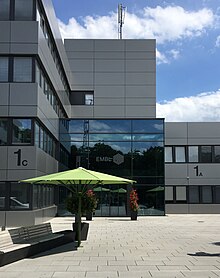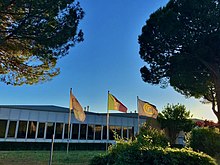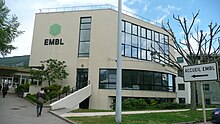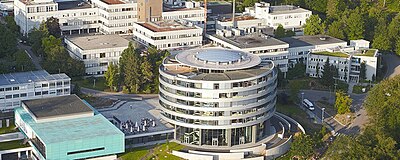European Molecular Biology Laboratory
[6] Their goal was to create an international research centre, similar to CERN, to rival the strongly American-dominated field of molecular biology.The first systematic genetic analysis of embryonic development in the fruit fly was conducted at EMBL by Christiane Nüsslein-Volhard and Eric Wieschaus,[16] for which they were awarded the Nobel Prize in Physiology or Medicine in 1995.EMBL has identified as a core mission the provision of advanced experimental and data services to external researchers, including structural biology, imaging and sequencing facilities at its five European sites.The centre is open to visiting scientists worldwide and provides a unique service facility for the life sciences by combining the latest imaging technologies with expert advice and industry-led developments not yet otherwise available.[21] The ATC also hosts EMBL's European Learning Lab for the Life Sciences (ELLS) which provides training for secondary school teachers on the latest developments in molecular biology, and runs a student outreach program.




Research instituteBasic researchHeidelbergBarcelonaGrenobleHamburgHinxtonMolecular biologyAustriaBelgiumCroatiaCzech RepublicDenmarkEstoniaFinlandFranceGermanyGreeceHungaryIcelandIrelandIsraelLatviaLithuaniaLuxembourgMontenegroNetherlandsNorwayPolandPortugalSlovakiaSwedenSwitzerlandUnited KingdomBulgariaSerbiaAustraliaEdith Heardintergovernmental organizationEuropean Bioinformatics InstituteLeó SzilárdJames WatsonJohn KendrewDirector generalLennart PhilipsonFotis KafatosIain MattajEMBL-EBIbioinformaticsstructural biologyepigeneticsneurobiologycell biologybiophysicsdevelopmental biologygenome biologycomputational biologyChristiane Nüsslein-VolhardEric WieschausNobel Prize in Physiology or MedicineJacques Dubochetcryogenic electron microscopyNobel Prize in ChemistryArgentinaEuropean Molecular Biology OrganizationEuropean Genome-phenome ArchiveBiographical Memoirs of Fellows of the Royal SocietyBibcodeWho's WhoOxford University Press